Hydrogen + Oxygen (Electrolysis)
After some success at burning hydrogen I decided to add oxygen to the mix. The simplest way to generate oxygen is electrolysis, which is also used to generate hydrogen at the same time.To get any decent amounts of gas in short periods of time you need a high current power supply. I'm using a bench top power supply with a variable voltage between 3V and 18V and a maximum current draw of 35A.
Platinum electrodes would be nice, but they're too expensive for my budget. So instead I'm using whatever I have available to me, which is usually nails and bolts.
You should note that these experiments are extremely dangerous and I in no way encourage you to perform them. Balloons filled hydrogen and oxygen are explosive and can go off with the touch of a hand. Also, hydrogen and chlorine gas mixtures can be set off with just light. Safety involving eye protection and distance is paramount.
NaCl
The first electrolyte used is a saturated salt water solution, which results in Na+ cations and Cl- anions.NaCl(s) -> Na+(aq) + Cl-(aq)
As the electrolyte is saturated with NaCl the anode has an easier time oxidizing the chlorine ions than it does the oxygen ions. The result is the production of chlorine gas.
2Na+(aq) + 2Cl-(aq) -> 2Na+(aq) + Cl2(g) + 2e-
It's important to note at this point that the voltage used during the electrolysis (between 10V and 15V) is high enough to cause an overvoltage effect, which is why the formation of chlorine takes preference over oxygen. If a lower voltage (1.23V) was used then the formation of oxygen would take preference over the chlorine. However, for my experiments such a low voltage is impractical.
Chlorine is highly reactive and will react with the water to form hydrochloric acid and hypochlorous acid,.
H2O(l) + Cl2(g) -> HCl(aq) + HClO(aq)
The hypochlorous acid is unstable and quickly decomposses to form hydrochloric acid and oxygen.
2HClO(aq) -> 2HCl(aq) + O2(g)
Once the water becomes saturated with chlorine the chlorine will stop disolving and will then remain as chlorine gas.
At the cathode reduction takes place with the formation of hydrogen gas and a hydroxide anion.
2H2O(l) + 2e- -> H2(g) + 2OH-(aq)
The hydroxide anion reacts with the sodium cation to become sodium hydroxide.
Na+(aq) + OH-(aq) -> NaOH(aq)
So it can be seen that the reaction at the electrodes produces chlorine gas, hydrogen gas, and hydroxide anions.
2H2O(l) + 2Cl-(aq) -> Cl2(g) + H2(g) + 2OH-(aq)
The oxygen produced is as a result of the chlorine not of the electrolysis. And further to this, oxygen is only produced while the water is not saturated with chlorine.
In the following sequence a balloon was filled with the gasses (hydrogen, chlorine, oxygen) produced during electrolysis of a saturated salt water solution. The measured current draw at 15V was around 25A, which results in a large amount of gas being produced in a short period of time as well as quite a lot of heat. The balloon was ignited with a homemade electronic ignitor.
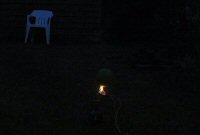 |
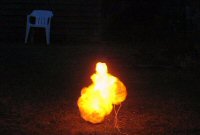 |
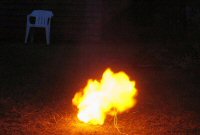 |
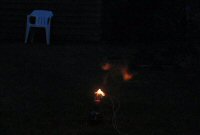 |
The fireball and noise produced by the balloon is more intense than a pure hydrogen balloon, which is due to the added chlorine and oxygen. However, with a higher ratio of oxygen the results should be more impressive.
H2SO4
The second electrolyte I've used is dilute sulphuric acid. The sulphuric acid is dissociated in water to form hydrogen cations and sulphate anions.H2SO4 -> 2H+ + SO42-
At the cathode the hydrogen cations gain an electron to form hydrogen gas.
2H+ + 2e- --> H2
At the anode oxygen is formed, but the oxygen does not come from the sulphuric acid. Instead the oxygen is coming from the H2O molecules.
2H2O(l) --> O2(g) + 4H+(aq) + 4e-
During the electrolysis process the sulphate anions remain in the solution, which results in an increase in the concentration of sulphuric acid.
The reaction at both of the electrodes produces hydrogen gas and oxygen gas in a 2:1 ratio.
4H+ + 2H2O --> 2H2 + O2 + 4H+
Igniting the hydorgen and oxyegn balloon results in a much louder boom and considerable more force. Infact, the explosion of the hydorgen and oxygen mix blew my conical flask to bits.
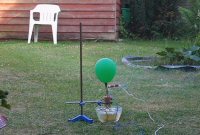 |
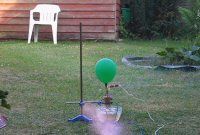 |
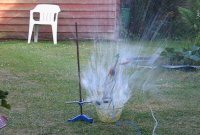 |
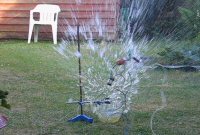 |
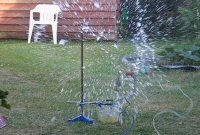 |
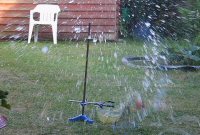 |
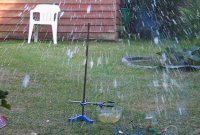 |
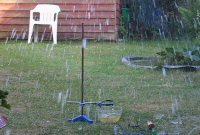 |
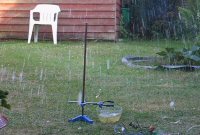 |
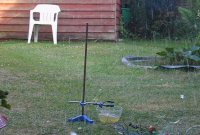 |
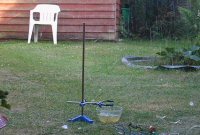 |
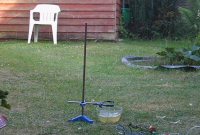 |
| Home |